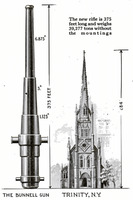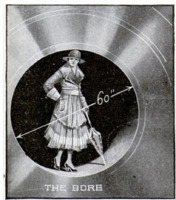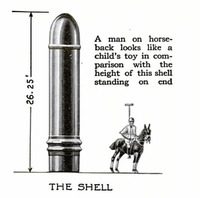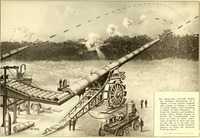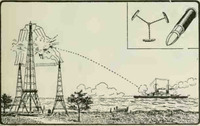Cannoni del futuro
La descrizione di versioni gigantesche di tecnologie già in uso è molto frequente nella divulgazione tecnico-scientifica della Prima guerra mondiale. Se le armi esistenti erano così letali, certamente aumentarne le dimensioni ne avrebbe accresciuto l’efficacia (e la spettacolarità agli occhi dei lettori).
Il Big Gun, ad esempio, avrebbe dovuto essere lungo 114 metri e capace di sparare proiettili da 100 tonnellate a una distanza di 160 km. Il cannone più grande effettivamente utilizzato durante il conflitto, il Paris-Geschütz, sparava proiettili da 100 kg con una gittata di 130 km.
Si consideri il super-cannone proposto Charles Beecher Bunnell su “Popular Science” (1917). Avrebbe dovuto misurare 114 metri e sparare proiettili da 100 tonnellate a 160 km di distanza. La Paris-Geschütz, probabilmente il pezzo di artiglieria più pesante realmente usato durante il primo conflitto mondiale, sparava proiettili da 100 kg a 130 km. Un proiettile sparato dall’immaginario “super-cannone” contenente gas tossici e lanciato contro una città (tedesca) “l’avrebbe resa una Valle della Morte per trenta giorni dopo la sua caduta”. Questa visione apocalittica, realizzata e superata dalla bomba atomica solo trent’anni più tardi, è criticata come “non probabile” dai redattori della rivista (come costruirlo? come trasportarlo? sarebbe stato davvero più efficiente dell’artiglieria in esistenza?) ma questo non impedisce alla rivista di solleticare l’immaginazione dei lettori con il confronto – una pratica frequente nella divulgazione delle tecnologie belliche – con innocui oggetti di conoscenza comune, come treni e automobili.
Su “Electrical Experimenter” (1915), invece, viene mostrato un cannone elettromagnetico, brevettato da diversi inventori dal 1915. Una serie di campi elettromagnetici creati in successione nella canna avrebbero dovuto spingere il proiettile verso il bersaglio senza esplosioni, fumo o rumore e senza surriscaldamento o deterioramento del fusto (oggetto di costante manutenzione dell’artiglieria reale). Il cannone avrebbe dovuto funzionare come un’enorme mitragliatrice, sparando 50-75 proiettili in un minuto a una distanza di 25 miglia. La sua efficacia in una guerra di posizione veniva enfatizzata sottolineando che: “una tale scarica di proiettili […] sbaraglierebbe rapidamente il nemico, indipendentemente da quanto sia ben trincerato o nascosto dietro terrapieni fortificati”.
L'immaginario di questa tecnologia scavalcava i confini nazionali. Un cannone simile è proposto anche su “La Science et la Vie” (1918), rimarcando che si trattava di “una macchina molto poco conosciuta, al di fuori degli specialisti, che merita di essere descritta, tanto per la sua originalità quanto per i servizi che potrebbe fornire”. Il super cannone arriva anche in Italia, come dimostra un articolo di “La Domenica del Corriere” (1918) nel quale l'arma (chiamata, in maniera molto evocativa, “cannonissimo”) è descritta come in grado di “lanciare un vero torrente di granate esplosive, a grande distanza”.
L’idea del cannone elettromagnetico sarebbe stata sviluppata dopo le due guerre e ha portato, in anni recenti, a svariati prototipi. La complessità dei meccanismi coinvolti nel suo funzionamento ne hanno, finora, impedito un reale impiego militare.
Un altro tipo di innovazione proposta nel campo dell'artiglieria su “Electrical Experimenter” (1917) era quella dell’utilizzo di proiettili legati insieme – ispirati alle palle incatenate utilizzate nei conflitti passati – che venivano considerati particolarmente efficaci per distruggere le strutture nemiche formate da cavi sospesi, come quelle del telefono, del telegrafo o dell’energia elettrica.
Popular Mechanics (1916) riporta che lo stesso Presidente degli Stati Uniti Woodrow Wilson aveva avuto l'idea di un sistema di difesa costiera. Il progetto prevedeva la costruzione di un tipo speciale di carro ferroviario su cui montare dell’artiglieria pesante. Questi vagoni armati sarebbero stati collocati “in stazioni opportunamente posizionate, da dove potrebbero essere inviati ad alta velocità in qualsiasi punto in cui si rendesse necessario respingere un’invasione”. Sul piano economico, si stimava che tale sistema avrebbe comportato “una spesa di poco superiore a quella di una moderna corazzata”.
Anche durante la Seconda guerra mondiale si propongono nuove forme di l’artiglieria. Una di esse fu un siluro lanciato da un cannone. A proposito di questa tecnologia, su “Scientific American” (1942) si afferma: “Oltre alla spinta fornita dal cannone al momento del lancio, secondo il metodo consueto, questo siluro è dotato anche di ulteriori mezzi di propulsione, nascosti nella parte posteriore del suo corpo, con una combinazione studiata per conferire al proiettile un’ampia gittata e un’elevata velocità sia nell’aria che nell’acqua”. Si rimarca inoltre che uno di siffatti siluri da circa 30 cm sarebbe stato in grado di trasportare intorno ai 159 kg di “esplosivo ad alto potenziale”.
Scritto da Alberto Bordignon e Federico Mazzini
Esplora l'artiglieria del futuro nel nostro database
-
 Shooting Shells of a Hundred Tons
Shooting Shells of a Hundred Tons -
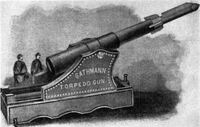 Torpedo Gun
Torpedo Gun -
 Le nuove armi dell'esercito americano
Le nuove armi dell'esercito americano -
 Super Range Guns
Super Range Guns
